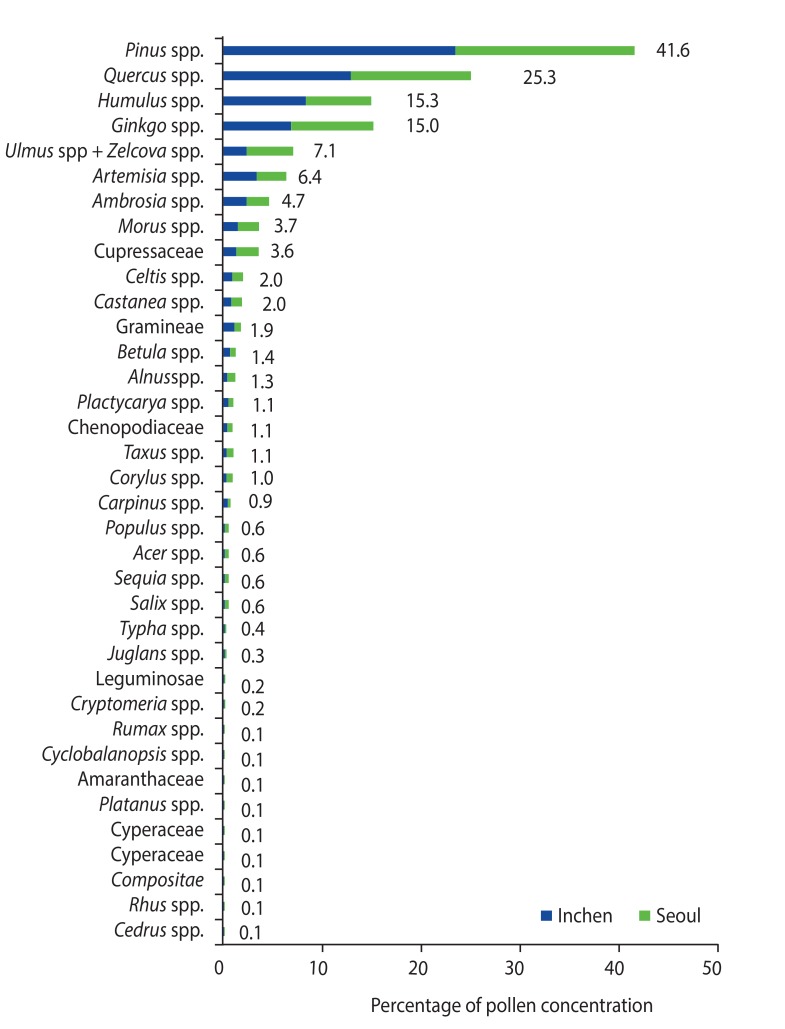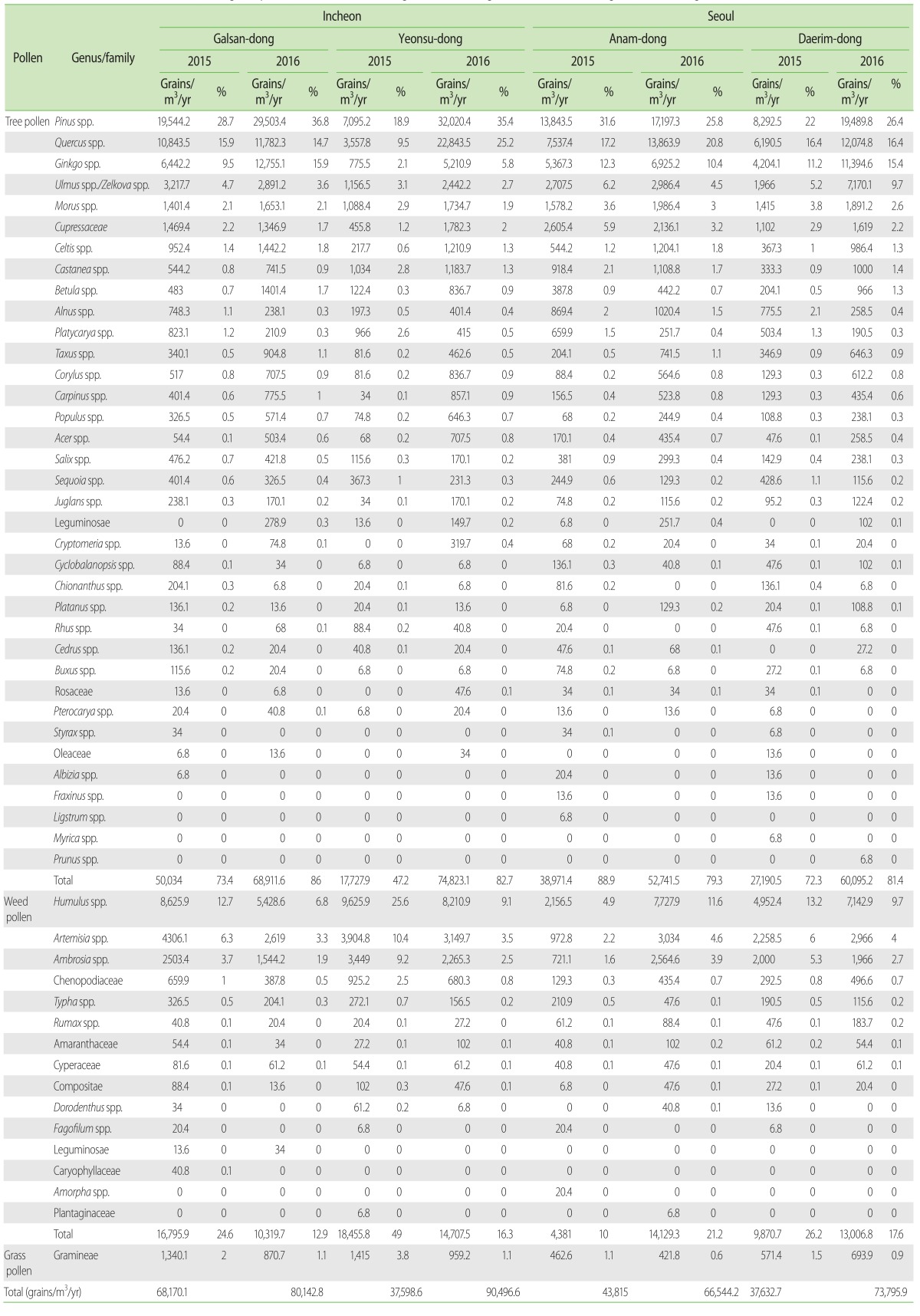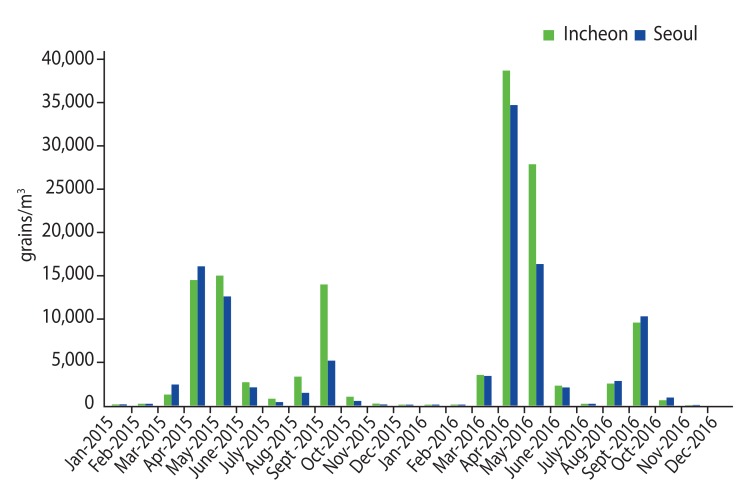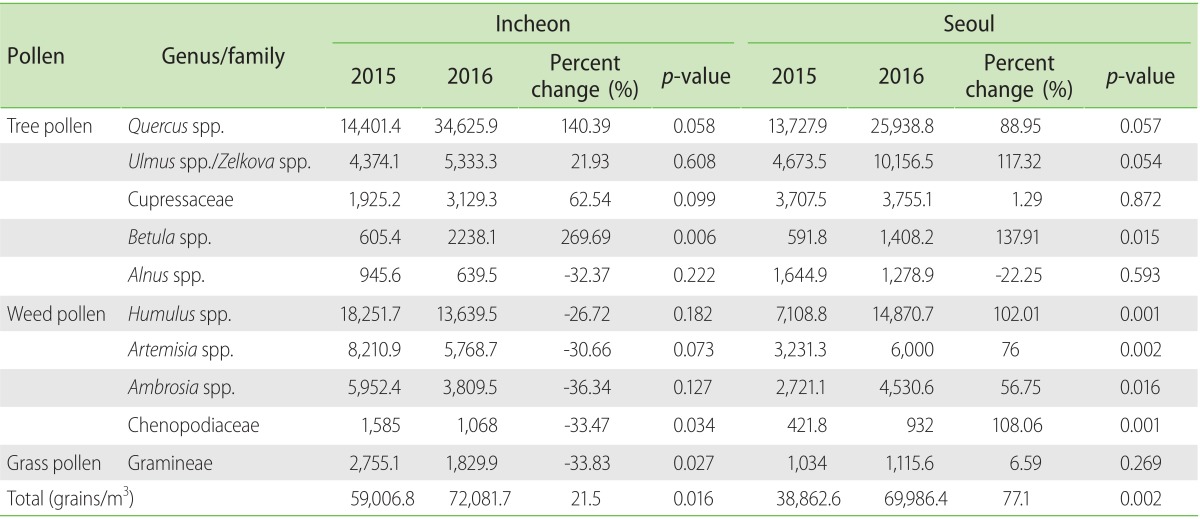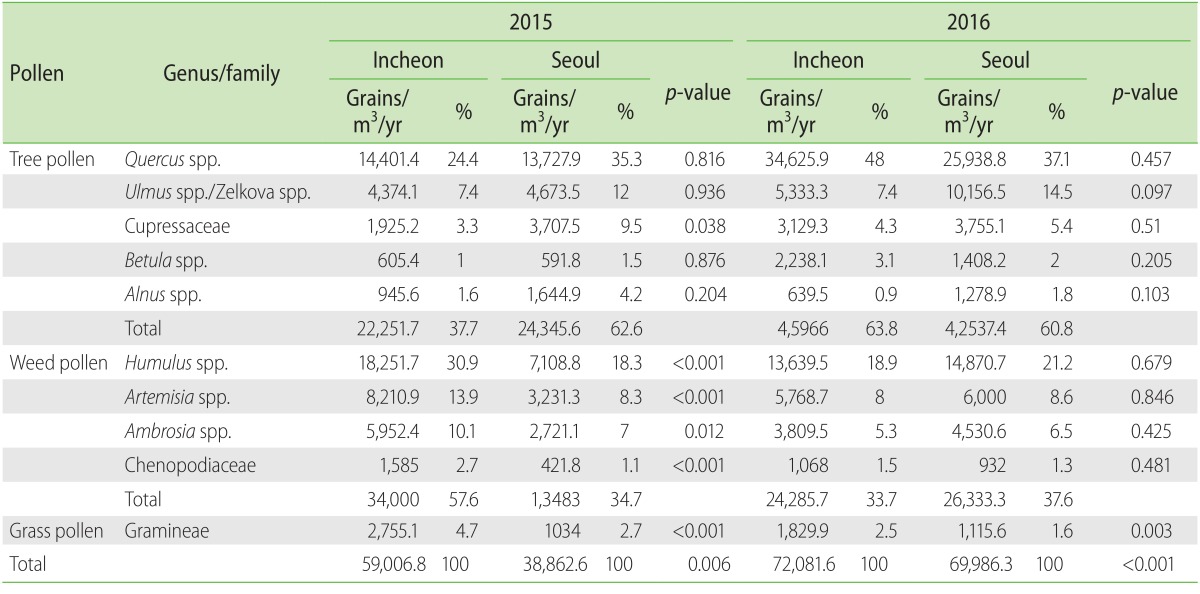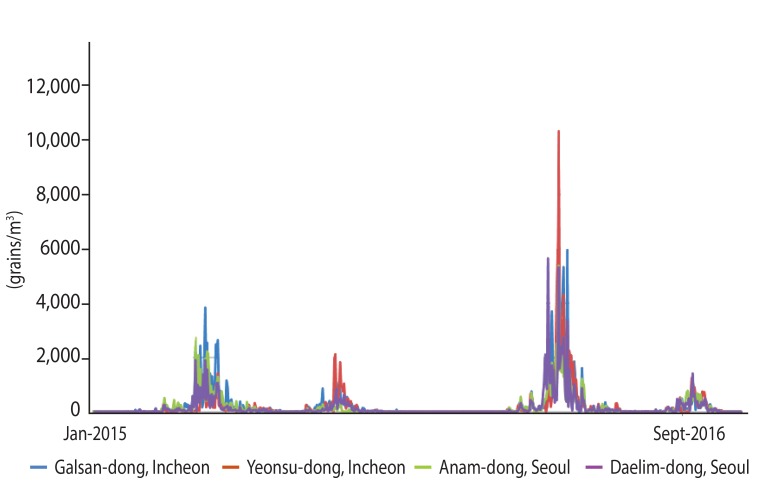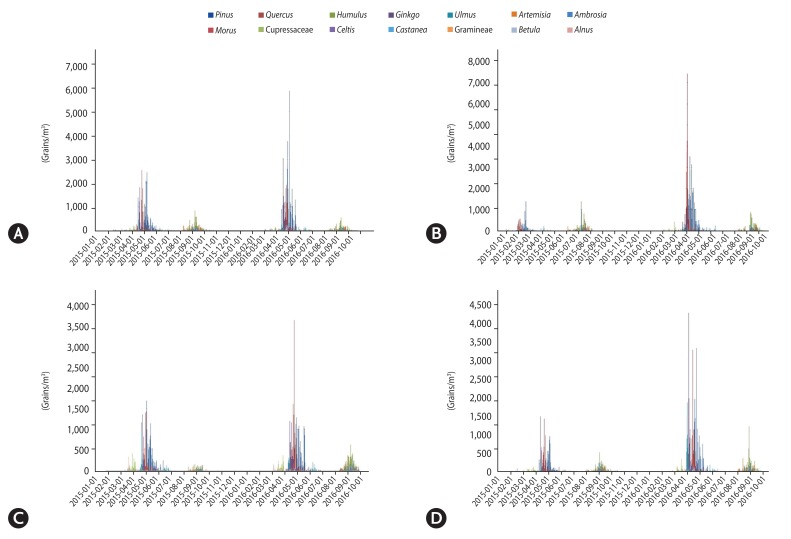Abstract
Background
Pollen allergens are one of the main contributors to the development and/or aggravation of allergic rhinitis, allergic conjunctivitis, and asthma.
Objective
An examination of the airborne pollen in residential areas should be conducted to aid the diagnosis and treatment of allergic diseases.
Methods
Airborne pollen samples were collected from 2 sites in Incheon and 2 in Seoul from 2015 to 2016.
Results
The highest monthly concentration of airborne pollen was observed in May and September each year. Pollen from 32 families and 50 genera was identified over the 2 years; of these, Pinus spp. showed the highest pollen concentration (41.6%), followed by Quercus spp. (25.3%), and Humulus spp. (15.3%), the latter of which had the highest concentration among weed pollen. The total pollen concentration was significantly higher in Incheon than in Seoul (p = 0.001 in 2015, p < 0.001 in 2016) and higher in 2016 than in 2015. The concentrations of pollen from weed species (Cupressaceae, Humulus spp., Artemisia spp., Ambrosia spp., and Chenopodiaceae) and grass species (Gramineae) were significantly higher (p < 0.001) than those from tree species. Pollen was distributed from February to November. The first pollen identified in both regions in each year was Alnus spp. Overall, the total concentration of Quercus spp., Betula spp., Humulus spp., Artemisia spp., Ambrosia spp., and Chenopodiaceae pollen increased significantly over the 2 years.
Conclusion
Region-specific differences exist in the pollen of major allergenic plants. Continuous monitoring of pollen is thus essential for management of pollen-related allergic disorders in each region.
Keywords: Pollen, Allergens, Allergy
INTRODUCTION
Airborne pollen is a potential cause of pollinosis, which is induced or exacerbated during the peak of the pollen season. The most typical types of pollinosis are allergic rhinitis, asthma, allergic conjunctivitis, and atopic dermatitis [1,2,3,4,5]. Since the investigation of airborne pollen distributions is essential for the diagnosis and treatment of allergic diseases, multiple surveys and studies have been performed in the United States, Europe, and Japan [6,7,8]. Several studies have also carried out in South Korea to investigate the association of airborne pollen and climate with allergic diseases [9,10,11,12,13,14,15,16].
Airborne pollen concentrations vary by region and season; thus, the use of reliable sampling methods is considered crucial for the continuous monitoring and analysis of pollen. The sampling sites need to be airy, easily accessible to facilitate the change of trapping drums, and appropriate to measure the airborne pollen distribution of the surrounding environment. In this study, we aimed to investigate pollen concentrations and seasons, changes in the major allergic pollen types, and regional differences over a 2-year period in Incheon and Seoul using pollen traps established at four different sites.
MATERIALS AND METHODS
Pollen sampling
Pollen sampling was carried out in 4 sites, 2 in Incheon (Incheon Women's Cultural Center at Galsan-dong and Incheon Red Cross Hospital at Yeonsu-dong) and 2 in Seoul (Korea University Anam Hospiral at Anam-dong and Hallym University Kangnam Sacred Heart Hospital at Daerim-dong) between January 1, 2015 and November 30, 2016 (Table 1).
Table 1. Sampling sites in Incheon* and Seoul†.
*Incheon Women's Cultural Center at Galsan-dong and Incheon Red Cross Hospital at Yeonsu-dong. †Korea University Anam Hospiral at Anam-dong and Hallym University Kangnam Sacred Heart Hospital at Daerim-dong.
Airborne pollen was sampled using a Burkard spore trap (Burkard Scientific, Hertfordshire, UK) installed on the rooftop of each building. The Burkard sampler is a vacuum pump that continuously samples air particles for 7 days at a consistent flow rate of 10 L/min. Samples were retrieved weekly on the same day.
Pollen identification and observation
Pollen samples were stained with gentian violet solution (10-g gelatin, 60-mL glycerin, 1.0-mL 0.1% gentian violet in alcohol, 0.3-mL phenol, and 35-mL distilled water) and observed under an optical microscope at 400 magnification. Airborne pollen counts (grains/m3) were obtained by examining the central portions of the slides as suggested by the Pan-American Aerobiology Association and using the following equations:
| Partides/(m3) = (counted/v) |
where the field diameter of objective was, drum rotation was 33.33 µm/min, and the flow rate was 0.01 m3/min.
RESULTS
Airborne pollen types
Airborne pollen samples collected from the 4 sites in Incheon and Seoul comprised 32 families and 50 genera. Of these, 20 families and 35 genera were arboreal, whereas 12 families and 15 genera were herbaceous (Table 2). Pinus spp. showed the highest pollen concentration (41.6%), followed by Quercus spp. (25.3%), Humulus spp. (15.3%), Gingko spp. (15.0%), and a mix of Ulmus spp. and Zelkova spp. (Ulmus spp./Zelkova spp.; 7.1%) (Fig. 1).
Table 2. List of pollen types recorded in Incheon and Seoul over 2 years (2015–2016).
Fig. 1. Percentage of pollen concentration by genus in Incheon and Seoul over 2 years (2015 and 2016).
Pinus spp. pollen, which was the predominant tree pollen, showed the highest concentration at Galsan-dong, Incheon in 2016 (29,503.4 grains/m3, 36.8%), whereas Humulus spp. pollen, which was the predominant herb pollen, showed the highest concentration at the same site in 2015 (9,625.9 grains/m3, 25.6%) (Table 3).
Table 3. Pollen concentration of tree, weed, and grass species recorded at Galsan-dong and Yeonsu-dong, Incheon and Anam-dong and Daerim-dong, Seoul in 2015 and 2016.
Pollen dispersion pattern
Airborne pollen reached the maximum concentration in spring and fall. In spring, concentrations stared to rise in March, reaching a peak in April in both regions (2-year average pollen concentration: 25,023.8 grains/m3 in Incheon; 24,428.6 grains/m3 in Seoul). In fall, concentrations started to rise in August, reaching a peak in September (2-year average pollen concentration: 11,826.5 grains/m3 in Incheon; 7,794.2 grains/m3 in Seoul) (Fig. 2).
Fig. 2. Average monthly pollen concentrations in Incheon and Seoul over 2 years (2015 and 2016).
Concentration changes in major allergenic pollen types over 2 years
Both in Incheon and Seoul, pollen concentration was significantly higher in 2016 than in 2015 (p = 0.016 in Incheon; p = 0.002 in Seoul). In Incheon, the pollen concentration of Betula spp. significantly increased (p = 0.006), whereas that of Chenopodiaceae (p = 0.034) and Gramineae (p = 0.027) significantly decreased over the 2 years. In Seoul, the pollen concentration of Betula spp. (p = 0.015), Humulus spp. (p = 0.001), Artemisia spp. (p = 0.002), Ambrosia spp. (p = 0.016), and Chenopodiaceae (p = 0.001) significantly increased over the 2 years (Table 4).
Table 4. Average annual concentration and percent change of major allergic pollen types in Incheon and Seoul.
Concentration of major allergenic pollen types in Incheon and Seoul
The concentration of the major allergenic pollen types was significantly higher in Incheon than in Seoul (p = 0.006 in 2015, p < 0.001). In 2015, the pollen concentration of Humulus spp. (p < 0.001), Artemisia spp. (p < 0.001), Ambrosia spp. (p = 0012), Chenopodiaceae (p < 0.001), and Gramineae (p < 0.001) was significantly higher in Incheon than in Seoul, whereas that of Cupressaceae (p = 0.038) was significantly higher in Seoul than in Incheon. In 2016, the pollen concentration of Gramineae was significantly higher in Incheon than in Seoul (p = 0.003) (Table 5).
Table 5. Concentration differences in major allergic pollen types between Incheon and Seoul in 2015 and 2016.
Maximum pollen concentrations
In the spring, the maximum pollen concentration was found at Galsan-dong, Incheon in 2015 (3,844 grains/m3) and at Yeonsu-dong, Incheon in 2016 (10,340 grains/m3). In the fall, the maximum pollen concentration was found at Yeonsu-dong, Incheon in 2015 (2,122 grains/m3) and at Daerim-dong, Seoul in 2016 (1,415 grains/m3) (Fig. 3).
Fig. 3. Average monthly pollen concentrations at Galsan-dong and Yeonsudong, Incheon and Anam-dong and Daerim-dong, Seoul over 2 years (2015 and 2016).
Distribution of allergenic pollen types
Tree pollen predominated from March to May, whereas weed pollen predominated from August to October (Figs. 4, 5). The pollen season of Alnus spp. started in mid-February in both regions; that of Ulmus spp./Zelkova spp. started in early March in Incheon and mid-March in Seoul, reaching peak levels in mid-April; that of Cupressaceae started in mid-March in both regions and lasted until early May, reaching peak levels in early April; that of Betula spp. started in mid-March and peaked in April; whereas that of Quercus spp. reached peak levels from mid-April to mid-May and continued until June.
Fig. 4. Pollen season of major allergenic plants in Incheon (A) and Seoul (B) over 2 years (2015 and 2016). Average of 10-day pollen counts in grains/m3.
Fig. 5. Average monthly pollen concentrations of major allergenic plants at Galsan-dong (A) and Yeonsu-dong (B), Incheon and Anam-dong (C) and Daelim-dong (D), Seoul over 2 years (2015 and 2016).
Among weeds, the pollen season of Humulus spp. ranged from early August to late October in both regions, reaching a peak in mid-September in Incheon and in early and mid-September in Seoul; the pollen season of Artemisia spp. ranged from early August to late October in both regions, reaching a peak concentration in mid- and late October in Incheon and from late August to late September in Seoul; the pollen season of Ambrosia spp. started in mid-August in both regions and lasted until early October in Incheon and until late October in Seoul, reaching a peak concentration from early to mid-September. Among grasses, the pollen season for Gramineae ranged from mid-May to mid-October in Incheon and from late April to late September in Seoul (Fig. 4).
DISCUSSION
In this study, pollen samplers were established at 4 sites in Incheon and Seoul to monitor airborne pollen concentrations over a period of 2 years. Airborne pollen reached peak concentrations in the spring and fall, with tree pollen predominating from March through May and weed pollen predominating from August through October. Pinus spp., Quercus spp., and Ginkgo spp. showed the highest pollen concentrations among the trees; Humulus spp., Artemisia spp., and Ambrosia spp. among the weeds; and Gramineae among the grasses. The total concentration of pollen was higher in 2016 than in 2015. The pollen concentration of Betula spp. in Incheon and also of Betula spp., Humulus spp., Artemisia spp., Ambrosia spp., and Chenopodiaceae in Seoul increased in 2016. However, the peak concentration was observed at Yeonsu-dong, Incheon.
The major types of airborne pollen showed similar annual patterns. The pollen season of trees ranged from February to May, usually reaching a peak in April, and that of weeds ranged from August to October, usually reaching a peak in September, whereas that of grasses ranged from April to October. These results were in agreement with those reported by Suk and Nam [4] regarding the pollen season of weeds (August–October) at Gyeongsan in 2004, but not of trees (March–June) and grasses (May–October), which started a month later than observed in the present study. Our findings were also in agreement with the nationwide (including Seoul) pollen season of trees and weeds [13]; however, the pollen season of grasses could not be compared, since no data have been reported previously.
Airborne pollen collected from Incheon and Seoul in 2015 and 2016 comprised 32 families and 50 genera, showing a higher diversity than that reported by Sung et al. [17] (19 species in 1998–2012) and that reported by Park et al. [13] (15 tree species and 8 weed species in 1997–2007). The present study included all the 16 major pollen types reported in previous studies [13], which were carried out in 7 major regions of South Korea, as well as Chenopodiaceae, which is also an allergenic pollen type. Although weed and grass pollen concentrations are lower than tree pollen concentrations, an accurate classification is essential, since allergenicity varies among plants [18].
In 2015, the peak concentrations were recorded at Yeonsudong, Incheon in the spring (3,844 grains/m3) and the fall (2,122 grains/m3), whereas in 2016, the peak concentrations were recorded at Darim-dong, Seoul in the spring (10,340 grains/m3) and the fall (1,415 grains/m3). The peak concentrations were markedly higher than those reported by Oh et al. [10] at Guri, Seoul in the spring of 1997 (942 grains/m3) as well as in Jeonju in the fall of 1997 (742 grains/m3) and 1998 (555 grains/m3). The differences between the 2 studies could be attributed to regional differences, the heterogeneity of the sampling methods—since Oh et al. [10] used a Rotorod sampler—and also an increase in pollen concentrations through the years.
Pinus spp. showed the highest pollen concentration (129,933 grains/m3, 41.6%) among the arboreal species and Humulus spp. (47,621 grains/m3, 15.3%) among the herbaceous species. These 2 genera also showed the highest pollen concentrations in previous studies carried out in Korea, [13,17,19]; however, no quantitative comparisons could be made, since the previous studies presented only percentages and not pollen concentrations. In contrary, our findings were not in agreement with those reported by Suk and Nam [4] and Oh et al. [10], in which Artemisia spp. and Ambrosia spp. showed the highest pollen concentrations from August through October.
In Seoul, the peak pollen concentration of Humulus spp. was 1,401.4 grains/m3 and that of Quercus spp. was 3,625.9 grains/m3. Furthermore, the total pollen concentration of Humulus spp. in Seoul was significantly higher in 2016 (17,870.7 grains/m3) than in 2015 (7,108.8 grains/m3) (p = 0.001). Our results differ from those of previous studies; for example, Oh et al. [5] found that the peak pollen concentration of Humulus spp. was 900 grains/m3 and that of Quercus spp. 850 grains/m3 in Seoul and Guri in 2008, whereas Kim et al. [15] found that the peak pollen concentration of Humulus spp. was 600 grains/m3 in Seoul in 2008 and significantly increased from 2006 to 2008. Any inconsistencies among the studies could be attributed to regional differences or an increase in allergenic plants over the years.
Airborne pollen distributions vary by region and period, and thus, the continuous monitoring and observation of pollen within the same region is important to overcome any regional limitations and collect reliable data. Moreover, sampling needs to be performed in multiple locations, since samples generally contain pollen from the surrounding areas. In the present study, samplers were installed at 4 sites within the metropolitan area to increase the reliability of sampling, and the samples were analyzed by the same researcher to reduce the range of error. Unlike previous studies that collected pollen on a daily basis using the free fall method (Durham sampler or Rotorod sampler), we used the Burkard spore trap, the most globally standardized sampler, which continuously collects samples for up to 7 days and enhances data reliability by reducing the range of error; thus, our study represents a source of valuable information despite being conducted over only 2 years solely in a metropolitan region.
Our study revealed the airborne pollen concentrations at 4 sites in Incheon and Seoul over 2 years. Pollen seasons were longer and peak concentrations were higher than those previously reported. Additionally, we found that the total allergenic pollen concentration was significantly higher in Incheon than in Seoul and in 2016 than in 2015. To increase the accuracy of airborne pollen distribution and overcome any regional limitations, data need to be collected continuously via a standardized method and sampling to be performed nationwide. Overall, the continuous monitoring of major allergenic pollen types might substantially contribute to managing allergenic plants and developing effective countermeasures.
ACKNOWLEDGEMENTS
The authors thank the Incheon Women's Cultural Center, Incheon Red Cross Hospital, Korea University Anam Hospiral, and Hallym University Kangnam Sacred Heart Hospital, which provided assistance by collecting Burkard samplers for this study. This research was supported by the Ministry of Environment, Korea.
References
- 1.Oh SK, Seong HU, Lim DH, Kim JH, Son BK, Kim HC, Lee JY, Leem JH. Relationship between air pollutants and prevalence of allergic disease/pulmonary function in students in Incheon. Pediatr Allergy Respir Dis. 2010;20:264–276. [Google Scholar]
- 2.Nilsson ST, Spieksm FM. Traveller's allergy service guide. Stockholm (Sweden): Palynological Laboratory, Swedish Museum of Natural History, and Fisons Sweden AB; 1992. [Google Scholar]
- 3.Lee SY, Park JS, Lee KS, Hong CH. Pollen allergy in children (ll): the significance of tree pollen as a causative allergen in children with allergic diseases. J Korean Pediatr Soc. 1998;41:799–807. [Google Scholar]
- 4.Suk KD, Nam SH. The airborne pollen gains and the correlation with number of patients and medicine prescribed for allergies in Kyungsan. J Korean Soc Hyg Sci. 2004;10:143–153. [Google Scholar]
- 5.Oh YC, Kim HA, Kang IJ, Cheong JT, Kim SW, Kook MH, Kim BS, Lee HB, Oh JW. Evaluation of the relationship between pollen count and the outbreak of allergic diseases. Pediatr Allergy Respir Dis. 2009;19:354–364. [Google Scholar]
- 6.Prentice IC. Pollen representation, source area, and basin size: toward a unified theory of pollen analysis. Quat Res. 1985;23:76–86. [Google Scholar]
- 7.Romano B, Mincigrucci G, Frenguelli G, Bricchi E. Airborne pollen content in the atmosphere of central Italy (1982-1986) Experientia. 1988;44:625–629. [PubMed] [Google Scholar]
- 8.Yasaka M, Kobayashi S, Takeuchi S, Tokuda S, Takiya M, Ohno Y. Prediction of birch airborne pollen counts by examining male catkin numbers in Hokkaido, northern Japan. Aerobiologia. 2009;25:111–117. [Google Scholar]
- 9.Choi HS, Cho JS, Choo JH, Ko WK, Ahn HY. Allergic rhinitis to Japanese cedar in Cheju Island. Korean J Otolaryngol-Head Neck Surg. 1999;42:1129–1133. [Google Scholar]
- 10.Oh JW, Lee HR, Kim JS, Lee KI, Kang YJ, Kim SW, Kook MH, Kang HY, Kim JS, Lee MH, Lee HB, Kim KE, Pyun BY, Lee SI, Han MJ. Aerobiological study of pollen and mold in the 10 states of Korea. Pediatr Allergy Respir Dis. 2000;10:22–33. [Google Scholar]
- 11.Oh JW, Kang IJ, Kim SW, Kook MH, Kim BS, Shin KS, Hahn YS, Lee HB, Shon MH, Cheong JT, Lee HR, Kim KE. The correlation between increased sensitization rate to weeds in children and the annual increase in weed pollen in Korea. Pediatr Allergy Respir Dis. 2006;16:114–121. [Google Scholar]
- 12.Oh JW. Features and recent changes of airborne pollen in Korea. Korean J Asthma Allergy Clin Immunol. 2007;27:1–7. [Google Scholar]
- 13.Park KJ, Kim HA, Kim KR, Oh JW, Lee SY, Choi YJ. Characteristics of regional distribution of pollen concentration in Korean Peninsula. Korean J Agric For Meteorol. 2008;10:167–176. [Google Scholar]
- 14.Oh JW. Development of pollen concentration prediction models. J Korean Med Assoc. 2009;52:579–591. [Google Scholar]
- 15.Kim JH, Oh JW, Lee HB, Kim SW, Kang IJ, Kook MH, Kim BS, Park KS, Baek HS, Kim KR, Choi YJ. Changes in sensitization rate to weed allergens in children with increased weeds pollen counts in Seoul Metropolitan area. J Korean Med Sci. 2012;27:350–355. doi: 10.3346/jkms.2012.27.4.350. [DOI] [PMC free article] [PubMed] [Google Scholar]
- 16.Oh JW, Lee HB, Kang IJ, Kim SW, Park KS, Kook MH, Kim BS, Baek HS, Kim JH, Kim JK, Lee DJ, Kim KR, Choi YJ. The revised edition of Korean calendar for allergenic pollens. Allergy Asthma Immunol Res. 2012;4:5–11. doi: 10.4168/aair.2012.4.1.5. [DOI] [PMC free article] [PubMed] [Google Scholar]
- 17.Sung MS, Park YJ, Park GH, Oh JW, Kim SW. The correlation between allergy sensitization rate in pediatric and aerobiological study for airborne pollen in Busan for 15 years. Allergy Asthma Respir Dis. 2014;2:38–47. [Google Scholar]
- 18.Agashe SN, Caulton E. Aerobiology-Applications of airborne pollen studies in allergy. In: Agashe SN, Caulton E, editors. Pollen and spores: applications with special emphasis on aerobiology and allergy. Enfield (NH): Science Publishers; 2009. pp. 237–258. [Google Scholar]
- 19.Jung IY, Choi KR. Relationship between airborne pollen concentrations and meteorological parameters in Ulsan, Korea. J Ecol Environ. 2013;36:65–71. [Google Scholar]





